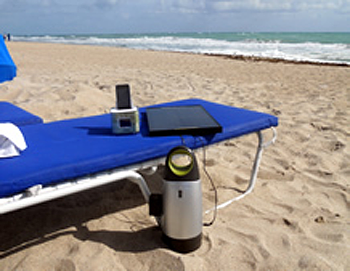Powerful and compact, the Boulder 15 watt portable flat solar panel is perfect for camping or a Saturday at the park. 15 watts of efficient monocrystalline solar technology, the Boulder 15 watt solar panel can be linked together with several other panels to give you all the power and convenience that lightweight ridged panels offer.
The Boulder 15 watt solar panel from Goal Zero is one of the best designs for portable ridged solar panels we have seen. All our solar energy consultants were pumped when we checked out the durable and lightweight aluminum frame on the Boulder 15 watt solar panel. The black monocrystalline solar panels are some of the most efficient available on the market. Monocrystalline solar is thought to be the workhorse of panels in the industry. Because monocrystalline is a purer form of silicon crystal, it is more efficient but also more expensive. The high price of monocrystalline solar panels also means you are getting more electricity production per square inch of panel that other types solar products. Another advantage of monocrystalline solar is the life expectancy is a minimum of twenty-five years and longer.
When Goal Zero designed the high efficient Boulder 15 watt solar panel they really covered all the bases. You can hang the Boulder 15 solar panel from just about anything and also chain multiple solar panels together using the quick clip (sold separately). The Boulder 15 watt solar panel has a handy power cord that allows you to easily plug the solar panel into the Extreme power packs (sold separately) storing the power you are producing in a battery for when you need it. The Boulder 15 watt solar panel is waterproof, but don’t place it underwater remembering the panel is producing electricity.
When using your Boulder 15 watt solar panel you should also consider shading. The Boulder 15 is a smaller version of its older brother. Because the monocrystalline solar cells are wired in series, if you shade one panel you can restrict the generation of electricity. If you shade a row, you can knock out the power entirely with what’s commonly called the Christmas tree effect.
While you are RV camping or at the park, a good rule of thumb to optimize your collection of solar energy is to angle the Boulder 15 at about the same latitude where you are using the panel. That means while camping in North Carolina, you might want to angle the Boulder 15 watt solar panel at about 35 degrees tilt and pointed directly south. A really cool method of making sure your Boulder 15 watt solar panels are at the optimum position is to take a block of wood, hold it on the face of the panel at noon until there is no shadow and you are in. We think you will be pleased with the performance of the Boulder 15 watt solar panel.

